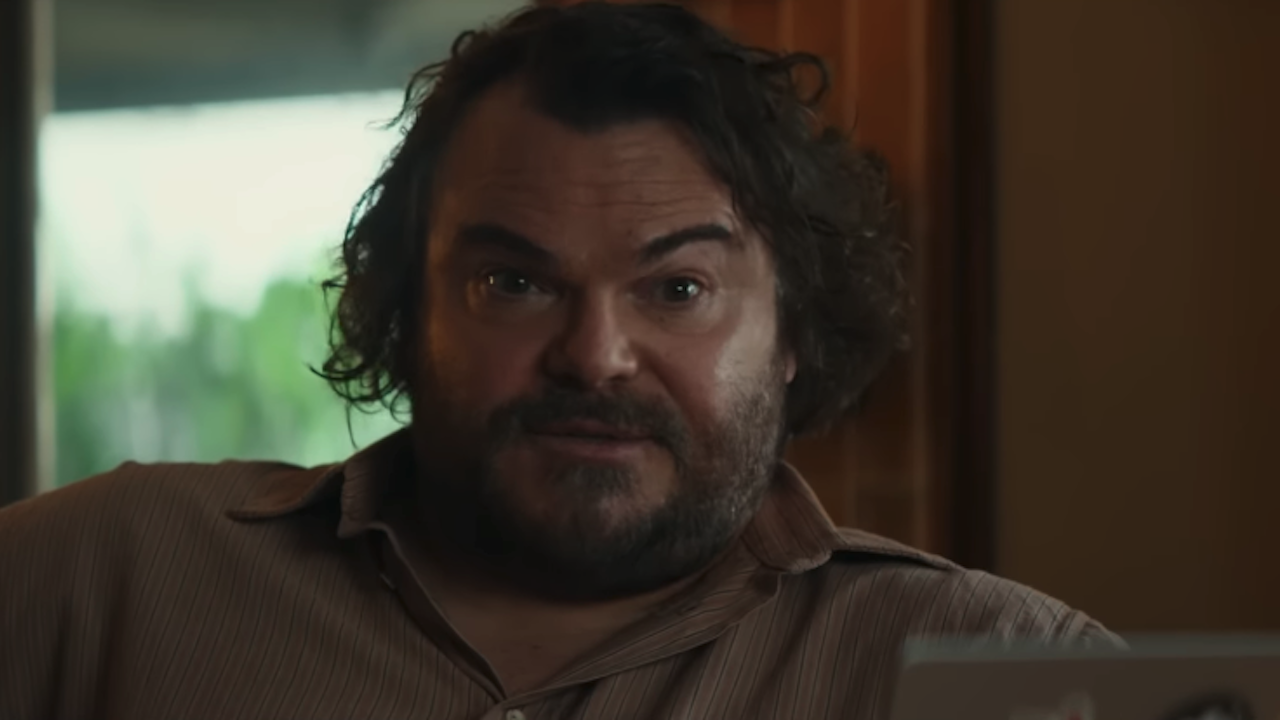The Biggest Differences Between The Cloud Atlas Book And Movie

Most sane directors in Hollywood took one look at David Mitchell's sprawling, densely layered novel Cloud Atlas and said "this is unfilmable." Luckily for all of us, Andy and Lana Wachowski and Tom Tykwer are at least a little bit insane, and decided not just to translate Mitchell's novel to the screen, but to alter its structure immensely while, somehow, keeping large sections of the original novel in place. It's an adaptation that looks nothing like the source material, but at the asme time, nails it perfectly.
So how do you even pull something like that off? The Wachowskis and Tykwer made three very large changes to the overall function of Cloud Atlas that made it even possible to film. The biggest came when they decided to ditch Mitchell's structure-- the stories all nested within one another-- and chop them up and layer them on top of each other and essentially make a salad out of what was a layer cake. Here's a quick diagram of the book's structure, for reference:
Click to enlarge

That rigid setup goes out the window from the first shot of Cloud Atlas, where we meet Tom Hanks as Zachry-- the main character of "Sloosha's Crossin'" recounting his story, then immediately meet Hanks again as Henry Goose, the villain of the book's first story, "The Pacific Journal of Adam Ewing." A montage introduces all the main characters in quick succession and ends, just before the main titles, with Robert Frobisher climbing into a bathtub and narrating his final letter to Rufus Sixsmith.
SPOILER ALERT FROM HERE ON OUT. If you have not read Cloud Atlas or seen the movie and don't want to know what happens, leave this article! If you have read the book and haven't seen the movie, it's your call if you want some of these structural surprises revealed.
So, the three major overarching changes between Cloud Atlas the book and the movie.
The structure. Gone are the neatly nested stories, in which each character reads the story of the previous one through a book or letters or manuscript or futuristic orb. In its place is a series of montages, overlapping dialogue and deft edits that draw all kinds of parallels among the stories that you might not have noticed, and allows the rise and fall of the stories to synch up in consistently unexpected ways.
Your Daily Blend of Entertainment News
The actors all play multiple roles. In the book there is a suggestion of a single soul reoccurring throughout time, thanks to a comet-shaped birthmark that appears on Robert Frobisher, Luisa Rey and other characters. That idea is expanded dramatically in the movie, in which actors reoccur in most if not all of the timelines, sometimes as similar characters-- Hugo Weaving is a bad guy in all of them, though he transforms into a nurse in one-- and sometimes dramatically different ones, as when Halle Berry goes from a tribal child to a Jewish woman in Scotland to the Hispanic American Luisa Rey. This drives home the theme of recurrence, but also helps engage you in characters you don't yet know-- you've seen Halle Berry as Luisa Rey already, so when she reappears as Meronym, you already feel like you know her.
Love is all around you. We only see one love story play out in the book of Cloud Atlas-- the relationship between Sonmi-451 and Hae-Joo Im-- and another, the one between Frobisher and Sixsmith, is hinted at. Both of these relationships are made stronger in the movie, and other romantic clinches-- between Adam Ewing and his wife Tilda, between Timothy Cavendish and his youthful flame, between Meronym and Zachry-- are added to give every single story an aspect of romance. There are other thematic additions, like the idea of every timeline including an imprisonment of some kind, but the love stories are the most significant, and make the movie Cloud Atlas significantly more sentimental than the book.
If you've read the book and want to go into the movie with a general idea of which changes to expect, that's pretty much everything you need to know. But if you want a more detailed breakdown of how each individual story has changed, well, that's really what this column is for. Over the next few pages I've broken Cloud Atlas down into the six individual stories and noticed the biggest story changes, though of course, in any adaptation, there are plenty of other smaller ones. Take a look and let me know of any others you noticed in the comments!
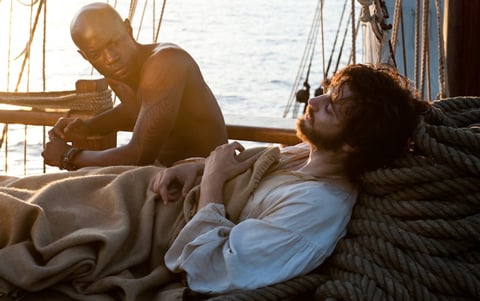
The Pacific Journal of Adam Ewing
His journey is streamlined significantly. This is true of all the stories, as you see, but whereas Adam Ewing's journey across the Pacific included several stops-- including in Hawaii to recuperate from his poisoning-- we see him on land only where he meets Dr. Goose and Autua, and then arriving home in San Francisco at the very end. The character of Horrox, whom he meets in a stopover, is transplanted to the first island, where he makes the same racist statements about the "natural order of things."
He doesn't hike into the volcano. This is a digression, so you won't miss it much, though the image of the corpses inside the bottom of the volcano is brought back when Zachry and Meronym finish their hike in "Sloosha's Crossin'."
The character of Rafael is cut. We see the toll a long Pacific journey can have through Ewing's observation of a deckhand named Rafael, who starts out bright-eyed and energetic and winds up hanging himself amid rumors of a homosexual affair with a shipmate. His story is another tangent that would be hard to delve into onscreen, but the suicide-- and the implication of homosexuality-- is an interesting parallel to Frobisher's.
We meet Ewing's father-in-law and Tilda. In one of the film's final scenes, Ewing arrives home at tells his father-in-law much of what he only writes to himself in the book-- that he wants to move East and join the abolitionists, that he owes his life to a self-freed slave. Tilda joins him. Significantly, the cargo Ewing is carrying across the ocean is also changed significantly-- he's been sent to the Pacific to sell a slave, and dramatically burns the contract in front of his father-in-law. In the book, Ewing is merely seeking out the beneficiary of a will.
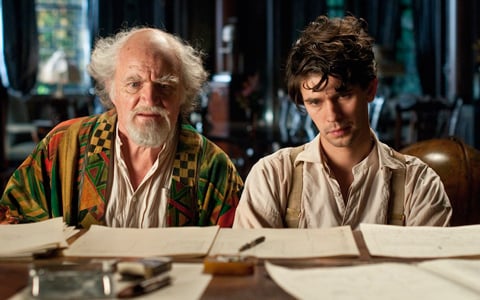
Letters from Zedelghem
He's in Scotland, not Belgium. This change doesn't materially affect any of the story, and allows the mansion where Vyvyan Ayrs live to become the same nursing home where Timothy Cavendish is later imprisoned-- a very neat swap.
We see Frobisher and Sixsmith together. Frobisher's letters to Sixsmith in the book, including lines like "that is why I love you" and "we both know in our hearts who is the sole love of my short, bright life" make their romance clear enough, but in the scene where Frobisher jumps out the hotel window to avoid paying his bill, he is in bed with Sixsmith-- a touching image that immediately evokes the depth of their relationship. In a wordless sequence of escape Frobisher says goodbye and borrows Sixsmith's waistcoat, gestures of love that strengthen the affection in the letters to come.
Eva is cut out entirely. It was surprising to re-read the book after seeing the movie and remembering what a huge role Ayrs's daughter Eva plays, as Frobisher is sleeping with both her and her mother Jocasta, and becomes infatuated with Eva to the point of self-ruin. But, as mentioned above, the Cloud Atlas movie is more focused on pure, eternal love, so there is more emphasis on Frobisher and Sixsmith's relationship, without the Eva infatuation to cloud things. It's one of the biggest changes in all the stories, but undoubtedly for the better.
Frobisher falls a bit for Ayrs… and also shoots him. The beats of the relationship between composer and assistant are roughly the same, but at a moment of connection Frobisher falsely senses a romantic spark between them-- a parallel of his Eva infatuation from the book, and a fascinating wrinkle to what's already a fascinating relationship. It gets even more complicated when Frobisher swipes Ayrs's gun and then accidentally shoots him. He doesn't kill him, but that causes the manhunt that eventually leads to his suicide.

Half-Lives: The First Luisa Rey Mystery
Javier Gomez is the author of her story. Yes, technically this detail emerges only in the Cavendish story, but because the stories are all intercut we learn this early-- and the fact that "Half Lives" is a manuscript, but one writen by a real character in Luisa's life, allows the story to be real instead of invented fiction. The movie Cloud Atlas eliminates most of the moments where characters doubt the authenticity of their stories-- like the reveal at the end of Sonmi-451's orison-- and the switch to Javier Gomez as author makes the story real, while also making his presence in the movie pretty touching.
A lot of the characters at Swannekke are cut. This is to be expected when you're truncating a story, especially one as twisty as Luisa Rey's mystery story. Fay Li is gone, as are any villainous henchmen aside from Bill Smoke-- which significantly alters the moment in the Mexican sweatshop where the woman strikes back with a wrench.
Luisa's mom is out too. Her dad remains an important figure, both as inspiration to Luisa and her link to Joe Napier. But the high-society mom is gone, as are all but the barest details about Luisa's life.
The finale on the sailboat is gone. To condense the action, Luisa and Joe Napier wind up facing off against Bill Smoke on the streets of San Francisco, and the various twists are cut down significantly. Luisa's story is probably the one that would make the most fun standalone story, so it's a little sad to see so much of this go.
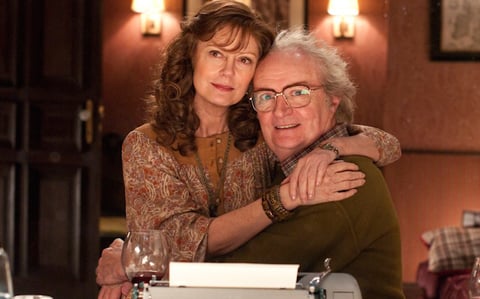
The Ghastly Ordeal of Timothy Cavendish
There is no Mrs. Latham. Timothy Cavendish's trusty secretary who helps him sort out the disaster his life becomes? Gone. The guy needs to be on his own against the world anyway.
He had an implied affair with his brother's wife, Georgette. In the book Georgette is a kind of half-insane lunatic, but int he movie we see her only briefly-- played, amusingly, by Ben Whishaw-- and it's implied that Denny resents his brother for sleeping with Georgette years earlier.
Timothy doesn't have a stroke. Honestly, this section is the truest to the book of any of them, since Timothy's story is rather compact anyway. And the fact that he has a stroke seems to largely be a convenient spot to break the story in half. You don't miss it at all in the movie version.
He reunites with his long-lost love. Timothy's story ends similarly to how it does in the book, as he writes his memoir a safe distance away from Aurora House, but there's a major change in that he's reunited with his old flame Ursula. Love conquers all in the movie version.
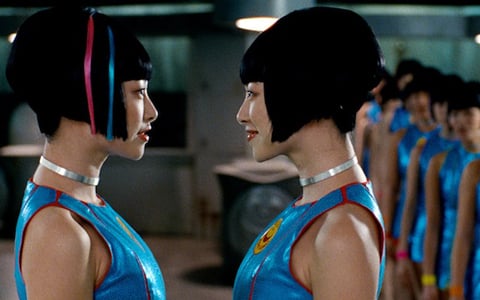
An Orison of Sonmi-451
The entire story set at the college is gone. OK, I lied about Luisa earlier-- clearly Sonmi-451's story would make the best standalone movie, and the richness of the detail in the book would easily make that happen. To condense her story and focus it on the romance with Hae-Joo, they have him rescue her from Papa Song and puts the two of them on the run immediately. No Boom-Sook shooting crossbows, no hours holed up learning everything… they cut right to the chase, literally.
Yoona-939 is inspired by Timothy Cavendish. In a neat change of how the story travels from one timeline to another, the stories that Yoona-939 sneaks out of bed to show Sonmi-451 are not fairy tales, but a video of the movie version of "The Ghastly Ordeal of Timothy Cavendish"-- which, in the book, Sonmi-451 watches with Hae-Joo. Timothy's line at the nursing home-- "I will not be subjected to criminal abuse"-- becomes Yoona-939's rallying cry when she strikes back at the consumers at Papa Song.
We see very little of the rest of the abolitionist movement. We meet Keith David briefly as the leader of the movement to free the clones, but for the most part, this is just Sonmi-451 and Hae-Joo's story.
There's no suggestion that Sonmi-451's story was created as a stunt. This is the biggest gut-punch in the book, where Sonmi-451 reveals that the government has set up her entire story to give the nation a fabricant scapegoat to fear-- and that she went along with it to get her message out anyway. Cloud Atlas the movie is more hopeful than the book, so we believe in the true love between her and Hae-Joo, and also that her mission really was one of revolution, and that her voice is heard for generations to come.
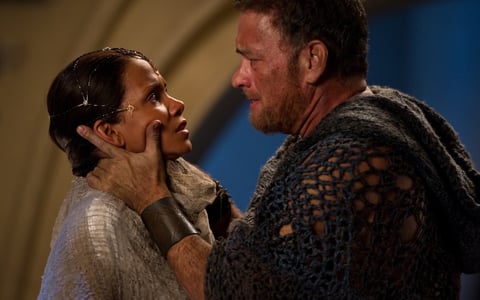
Sloosha's Crossin' An' Ev'rythin' After
The language is a little easier to understand. The made-up dialect in which the "Sloosha's Crossin'" section is told is one of the biggest hurdles for readers of Cloud Atlas, and had it been translated exactly, it probably would have required subtitles. So there are a few more standard English words tossed in, and in a fascinating spin, we see Meronym communicate back with home base on the ship, using perfectly clear modern English.
Humanity winds up settling in space, not on Hawaii. Zachry doesn't understand Meronym's motives in exploring the mountain until the very end of his story in the book, and it's fairly simple-- all of humanity that remains will wind up in Hawaii. In the movie, Meronym activates a satellite link to outer-space colonies, where she and Zachry wind up living at the end of the film. It gives their treacherous journey over the mountains a clearer purpose, and a much neater and clearer ending for the story.
The climax gets a lot more dramatic. In the book, Zachry and Meronym evade capture by the Kona by hiding under a bridge-- which happens in the movie too, but early on. At the end of the story they wind up facing down the warriors in the same glen where Zachry stood back and watched his brother get murdered, and it's a nice moment of redemption when Zachry then stands up this time, with him and Meronym each helping the other survive. Also, of course, it looks way better on film.
Meronym and Zachry fall in love. Tom Hanks and Halle Berry have the most major characters of anyone in the film, and what becomes a romantic attraction between Meronym and Zachry is a deliberate echo of the blossoming romance between Luisa Rey and Isaac Sachs. There's not a whole lot of emphasis on romance until the very end of the story, but it makes for a nice beat at the end.
Staff Writer at CinemaBlend

